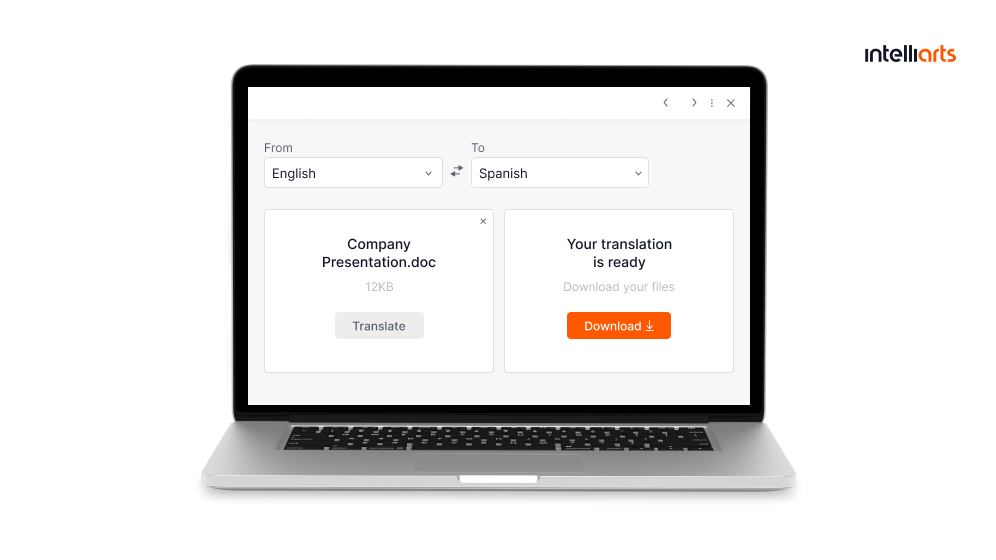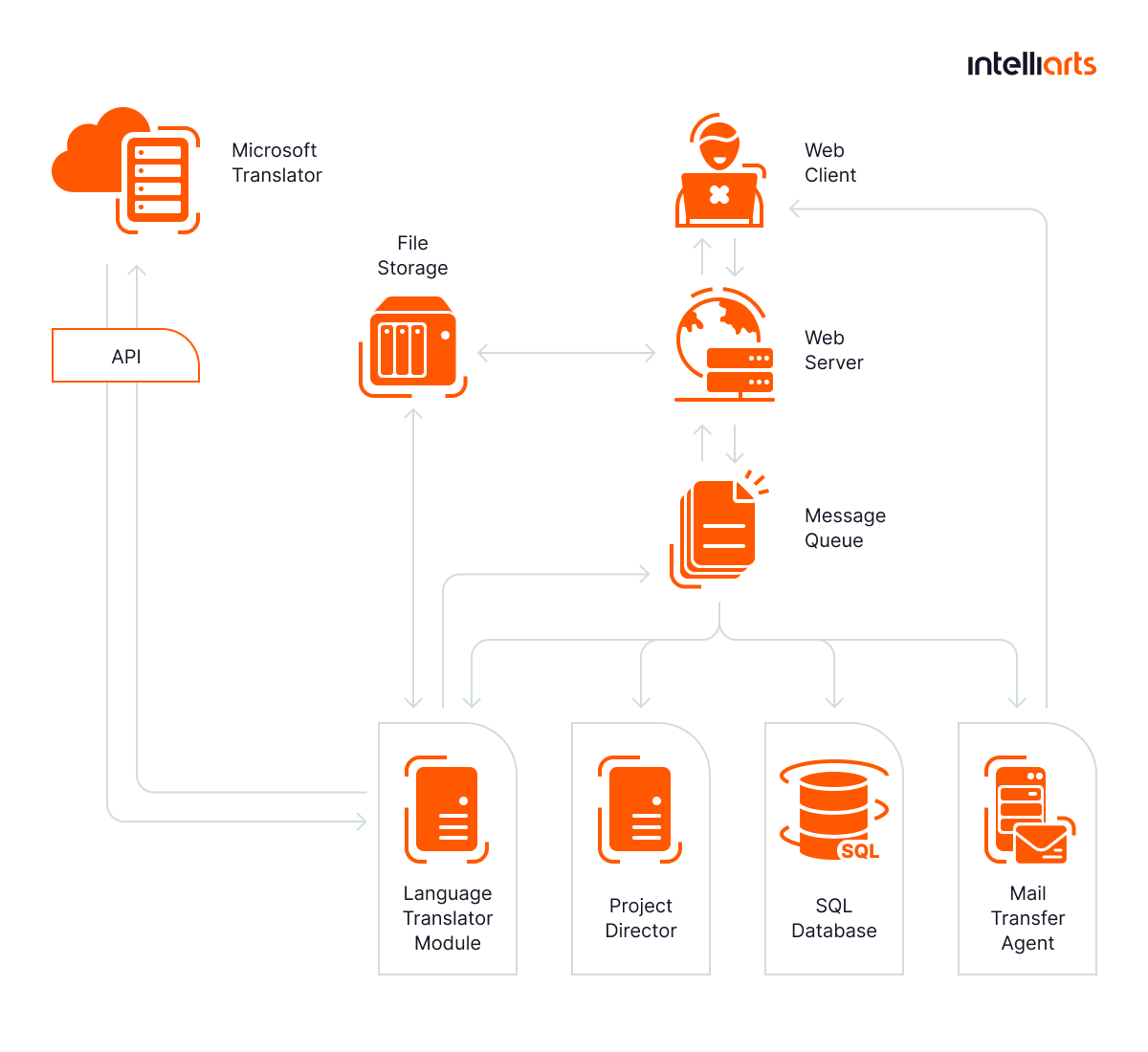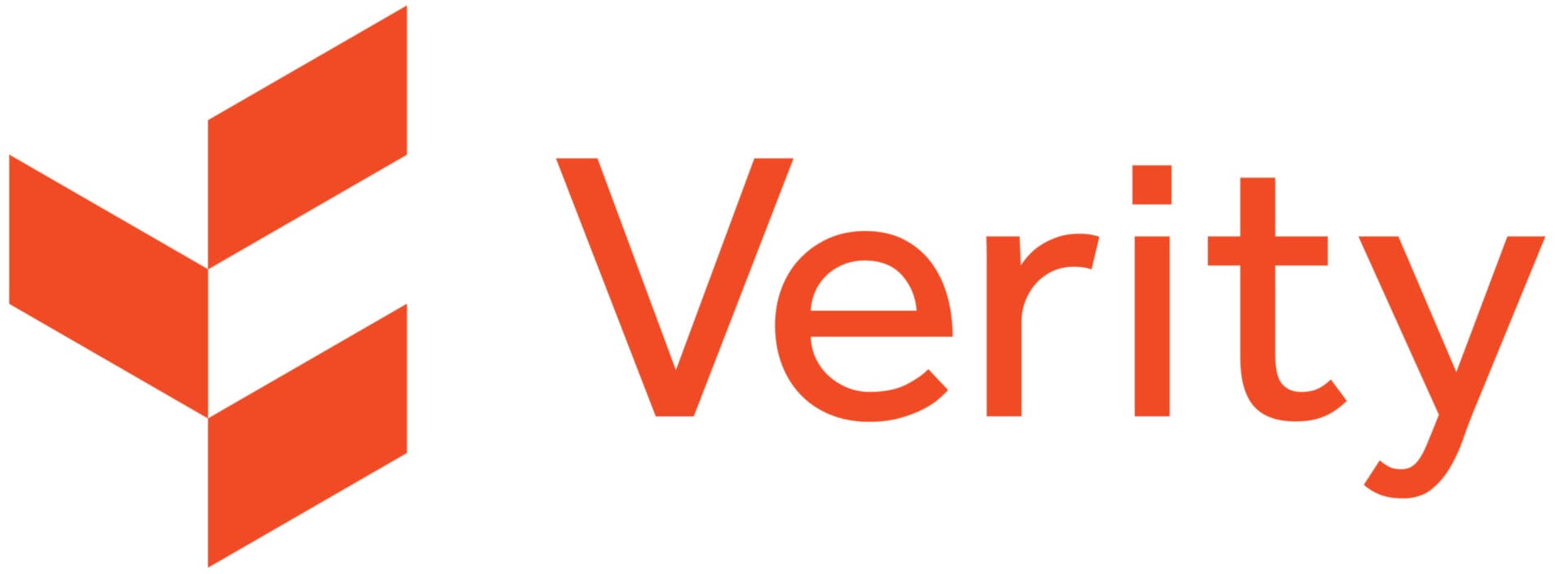Solution Highlights
- Delivered discovery consulting services for a portal for automated translations
- Reduced time spent on one translation — from 5-20 minutes to a few seconds
- Added an ability to keep track of the translation status
- Made it possible to translate many documents in parallel
- Created the system fault-tolerant to prevent disruptions

About the Project
Customer:
Dell EMC is a storage corporation with a parent organization of Dell Technologies. The company specializes in selling data storage solutions, information security, analytics, and cloud computing.
Challenges & Project Goals:
The customer contacted us with a clear product idea and a list of requirements, but a limited understanding of how to implement their solution from a technical standpoint. To provide multilingual content delivery and maintain consistent brand identity, Dell EMC planned to build an automated translation portal for translating internal corporate files automatically. The company had an early version of the translation portal, but since it didn’t meet the users’ expectations, they wanted to build a new solution from scratch.
After a series of first meetings, we defined the goals of the project:
- To design a Dell Translation Services Portal that can automatically translate different types of content and shows the status of translation to users (e.g. the translation is requested, processed, and finished)
- To build the web portal in-house and integrate it into the existing system
- To improve the processing time of Dell’s translations
- To make the platform fault-tolerant so it continued operation despite a possible failure of the system
Solution:
As a consequence of a few discovery meetings, Intelliarts provided the customer with a technology solution for how to re-architecture their translation portal so it met their precise requirements. We wrote a business proposal where we described how to implement the solution; provided details on the architecture and tech stack; phases of development and deliverables; project risks; rough budget and time estimates. After Dell’s approval, we moved on with machine translation solution development.
Business Value Delivered:
- The technology consulting phase helped the customer define technical requirements for their translation solution and understand how to turn their product idea into a reality. We also identified and described the phases of development and estimated the effort required and timeline.
- The solution development phase ended with a custom translation portal that we designed for Dell’s internal usage. The solution worked really fast, providing the end users with quality translations in a few seconds. The system was capable of handling several translations in parallel, and the status of the translation became visible to users. It also guaranteed the translation would be done despite possible system errors and was integrated into the customer’s existing system.
SaaS Development
Technology Solution
The customer requested consulting discovery services planning to build an automated translation services platform from scratch. Intelliarts piloted the project with a series of meetings to understand the customer’s business needs, project scope, and limitations.
Consulting discovery services
After completing technical feasibility validation and technology analysis, we suggested building a web portal that would use a microservice architecture and work based on Microsoft Document Translator, the tool for automatic document translation that the customer had already bought.
We summarized our recommendations in a detailed business proposal, where we:
- Described the system architecture and proposed to build a translation services platform composed of separate modules for better scalability and faster time-to-market
- Offered to build the solution gradually, without massive changes so it was simpler to deploy and fewer risks were involved
- Divided the project into a few phases, with clear deliverables after each of these
- Set approximate time and budget estimates for each phase as well as requirements for team composition
- Shared potential risks for the project, such as the component integration issue that was related to our limited knowledge and access to the customer’s existing source code and infrastructure; unclear requirements about the speed for translations; and possible communication blockers due to lots of stakeholders involved
Web portal development
As soon as we agreed on all the project details, our engineering team continued with the development of the translation services platform. Here are the key milestones of this phase:
- We started by building the solution for text translations and then extended it to document translations. The Intelliarts team of engineers designed the user interface (UI) as a web application, reusing Microsoft Document Translator in the backend. The platform worked in the following way: the web portal received a text or document from the user and uploaded it to the Microsoft tool. The latter translated the text and returned the translation to the web portal. Meanwhile, the user could follow the process by seeing the status of the translation and get the translation timely.
- Our next step was to make it possible to translate many documents in parallel. We implemented the queue data structure to configure load balancing. This helped the team to parallelize the job and perform multiple translations simultaneously, unlike in version 1. Dell EMC also got a chance to configure the maximum throughput of the system in terms of how many documents they needed to translate simultaneously. To put it another way, the company could optimize performance with the help of autoscaling.
- Here the Intelliarts team met a difficulty regarding the Microsoft tool we used. The software had a bug that didn’t allow us to run many instances simultaneously in order to be able to translate a bunch of documents at once. We solved this problem by fixing the bug in the Microsoft tool by finding its source code in the open source.
- Another interesting challenge we met was when configuring file storage. We had an access issue on the customer’s part, and to resolve this, the Intelliarts team had to interact with another department of Dell’s organization. We explained what type of expertise we needed within Dell, and they contacted us with the right person. Together, we configured the system so we got the access we needed.
- Thanks to all these changes, we reduced the processing time for Dell’s translations. While earlier the translation process lasted from 5 to 20 minutes, it took a few seconds after we redesigned the solution.
- After making it possible to translate texts and documents in parallel, the Intelliarts team started to work on making the translation portal fault-tolerant. We achieved that if any part of the product crashed at any time, the user wouldn’t even notice it. The system would continue working efficiently and without delays.
- The web portal was built entirely in-house, and we didn’t use any external dependencies. At the end of this stage, we also integrated the portal into Dell’s system.
Extending functionality
A great part of the project was about adding more features to the product. After version 2 was released, we started to extend the functionality of the translation portal. At this phase:
- The Intelliarts team made it possible to translate a wider range of file formats, from standard text files to presentations, excel files, etc.
- We also added advanced search functionality to allow users to search the already translated documents.
- The suggestion feature appeared useful to users to provide alternatives for words or phrases found in the translated files.
- Intelliarts recommended transferring file storage into Dell’s own cloud solution instead of creating new storage. Aside from saving company resources, this strategy would also help the company improve data storage efficiency and facilitate access.
- Another thing we started to work on involved the integration of the translation solution into Dell’s system responsible for automating the management of localization processes via GlobalLink Project Director.
Business Outcomes
At the end of our cooperation, Intelliarts provided a one-stop portal for Dell’s translations so the company could deliver a multilingual experience without a struggle. The customer was completely satisfied with the business outcomes:
- Productivity: Unlike earlier, users were sure that if they requested a translation, they would certainly get it.
- Synchronous translation process: The user sent the document for translation, waited a few seconds, and got it back. Earlier, the process was asynchronous since the user sent the file for translation and received it after some time (or might not receive it at all).
- Translation status: In version 1, users got an email when the translation was ready, now they could check the actual status in UI.
- Almost instant translation: The portal worked really fast — translation speed became measured in seconds instead of minutes. This allowed the employees to spend less time on translations and, hence, reduce costs.
- Operational efficiency: Faster and more efficient translation helped to improve Dell’s operational activities since the employees didn’t have to interrupt their work for translation anymore.
- Scale: The solution was capable of handling multiple translations simultaneously. Besides, the company got an opportunity to control the capacity of the system and optimize performance with the help of autoscaling.
- Fault-tolerance: The system was able to recover itself despite any failures or malfunctions.
- Integration: We built the translation portal in-house and fully integrated it into the customer’s existing system.







